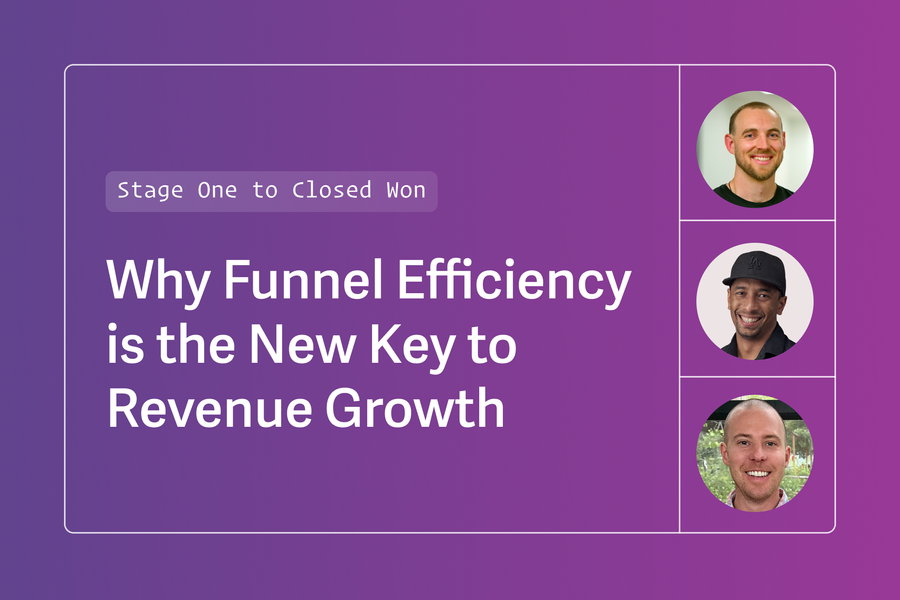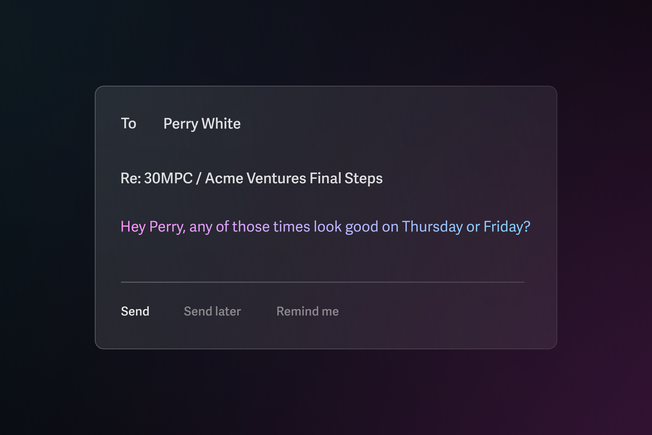
Every sales leader knows the feeling: your pipeline numbers look healthy, leads are flowing in, but deals get stuck in the middle.
Conventional wisdom often boils down to "more pipeline" or "better leads" — but top-performing revenue teams know that significant, sustainable growth can come from optimizing what happens after folks enter the pipeline.
In our recent virtual event — Why Funnel Efficiency is the New Key to Revenue Growth — Andrew Johnston, Head of Sales at Superhuman, hosted Kyle Norton, Chief Revenue Officer at Owner, and Kevin "KD" Dorsey, Chief Revenue Officer at Finally. They discussed how to transform middle-funnel effectiveness into a strategic advantage.
Here are three key themes for sales organizations looking to unlock their next phase of growth:
- How to identify and capitalize on the highest-impact opportunities in your sales process.
- Why disciplined iteration beats sweeping changes.
- How to strategically use AI to improve efficiency.
Find the 2X optimization opportunities
While top-of-funnel pipeline generation remains crucial for growth, Kyle and KD emphasized that many sales organizations overlook a major opportunity — optimizing their middle funnel.
"Most companies hit a pipeline mark that no longer has a 2x opportunity, but there are so many organizations that can absolutely 2x the number of people going from discovery to demo, and from demo to proposal."
— Kevin Dorsey, CRO at Finally
This focus on middle funnel optimization can drive significant results. When Owner.com's sales team applied this approach to their discovery-to-demo stage, they saw a 2.3x improvement in conversion rates.
Achieving such results requires identifying where deals typically stall. While each sales process will have its quirks, common mid-funnel bottlenecks include:
- Time-consuming cross-functional meetings that slow momentum
- Cumbersome deal desk processes and approvals
- Important emails getting buried
- Critical follow-ups falling through the cracks
Kyle introduced a practical framework for evaluating where to focus your optimization efforts. Think Payoff, Probability, and Perspiration.
- Payoff: What's the potential impact of improving this stage? For example, if one rep is converting at 40% while the team average is 17%, there's potential to double performance through standardization and leveling up.
- Probability: How likely are we to successfully implement this change? Is this about replicating proven practices from your top performers, or testing something completely new?
- Perspiration: What level of effort is required? Some improvements might require a complete rewrite of your demo script, while others might be as simple as implementing better sales collateral.
Once you've identified and prioritized how to improve your funnel, it begs the question — how do you implement these changes effectively?
The power of disciplined iteration
When it comes to improving your sales process, there's a crucial distinction between change and iteration. As KD explained, "Change happens after something big has occurred, or like we've missed two quarters in a row... Iteration is constant."
The key to iteration is focusing on one improvement at a time. "If you change your discovery and change how you do next steps, and your conversion rates are improving or not, you have no idea what's better," Kyle pointed out.
Instead, your reps should try one new thing at a time.
"Let [your reps] have a hypothesis and encourage them to test it."
— Kyle Norton, CRO at Owner
This approach requires a focused sequence:
- Set aside dedicated time for implementing changes (Kyle's team blocks specific time each week for this work)
- Give the changes enough time to become an "unconsciously competent skill"
- Document what works, for wider team adoption
- Move on to the next area for improvement
"There's a thing called the forgetting curve," Kyle noted. "If you teach somebody something one week and then never talk about it again, that is gone from their brain. So you need to reinforce for a series of weeks on that topic until it becomes their normal thing that they just do every time."
The most effective organizations create systems to support this iterative improvement. For example, KD's team uses what he calls the "four Ds" for scaling successful innovations:
- Define what's working
- Document the process
- Demonstrate it to the team
- Deliberately practice until it becomes standard
Use AI for internal efficiency
While such disciplined iteration is crucial, sales leaders should also continually look for opportunities to use AI and automation. Both Kyle and KD emphasized that AI, when applied thoughtfully, can remove administrative burden and create more space for focused improvements.
"AI is best placed internally, to make your organization better," Kyle explained. His team has developed sophisticated systems that transform how they operate behind the scenes. For example, they've built AI mechanisms that automatically monitor critical deal elements in calls, generating Slack alerts when specific triggers are detected — like whether a sales rep mentioned important terms or if a customer brings up potential red flags.
KD's team has taken a similar approach, using AI to analyze call transcripts to identify coaching opportunities and verify whether reps are effectively implementing the team's established practices. "I had my entire leadership team go through a six-week AI course," KD shared. "Since then, they've built out GPTs where we can upload the transcript and it tells us how well they did and where to coach."
The key is focusing AI on tasks that free up your team to do what humans do best. Common uses include:
- Pre-call research so reps can focus on relationship building
- Automated note-taking and follow-up tasks to maintain deal momentum
- Call summaries to help managers provide more targeted coaching
- Automated alerts for deal risks and opportunities
This strategic use of technology isn't about replacing human interaction — it's about enhancing it. By automating administrative tasks and providing better insights, teams can spend more time on high-value activities like building relationships, navigating complex negotiations, and continuously improving their sales process.
From stage one to closed won, faster than ever before
Pipeline generation is important, but as top-of-funnel tactics hit diminishing returns, sales leaders can turn middle-funnel efficiency into a lever for sustainable growth. A disciplined process of identifying opportunities, testing alternatives, and scaling what works is critical.
Ready to supercharge your sales process? See how Superhuman Mail helps sales teams maintain deal momentum and run more efficient cycles.
Get for Sales


